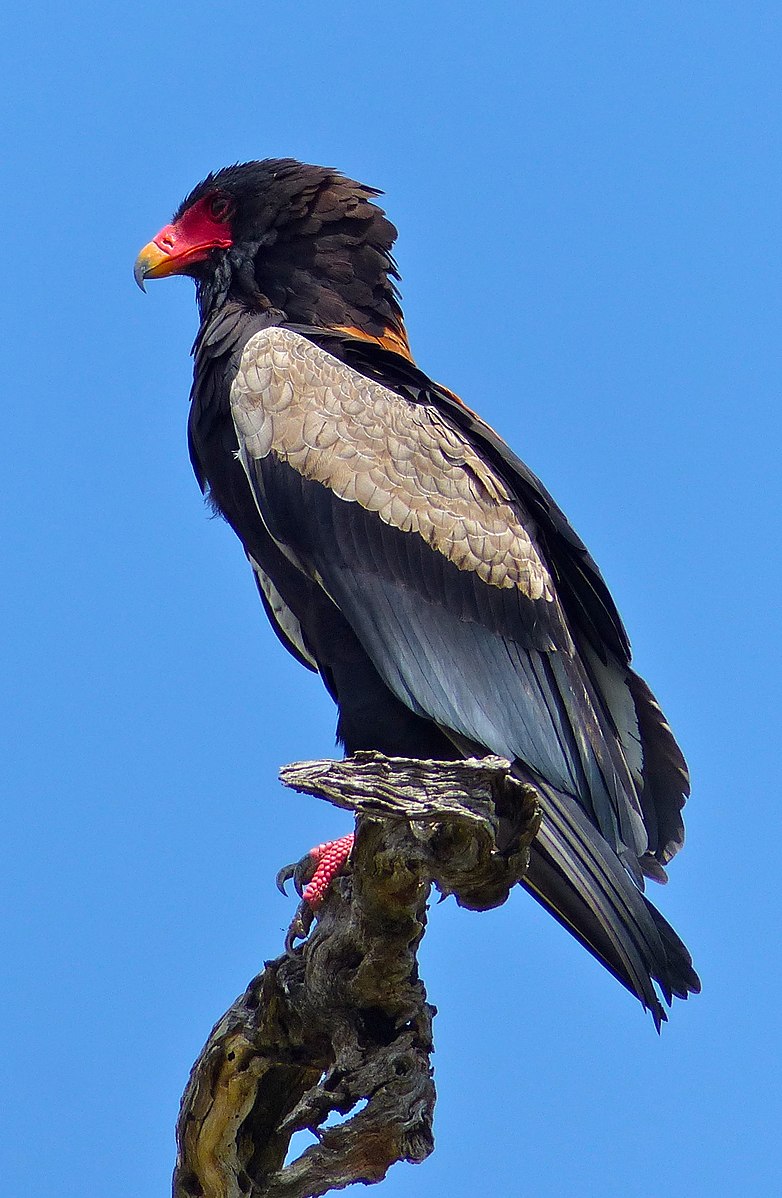Bateleur eagles are large birds of prey found throughout Africa, known for their distinctive appearance and hunting behaviors. However, contrary to popular belief, these eagles do not dive for fish as part of their diet. In this comprehensive blog post, we will explore the dietary habits and hunting strategies of the bateleur eagle, dispelling the myth that they are fish-diving raptors.
Bateleur Eagles: An Overview
The bateleur eagle (Terathopius ecaudatus) is a species of snake eagle found in various parts of Africa. These majestic birds are known for their unique appearance, with a black body, chestnut-red mantle, and a distinctive short tail that gives them a “tightrope walker” appearance in flight. Bateleur eagles are carnivorous, feeding on a wide range of prey, including mammals, reptiles, birds, insects, and even carrion.
Hunting Behavior of Bateleur Eagles
 Image source: Bateleur Eagle By Bernard DUPONT
Image source: Bateleur Eagle By Bernard DUPONT
Bateleur eagles are skilled hunters, using a variety of techniques to capture their prey. They are known to soar high in the sky, scanning the ground below for potential targets. When they spot their prey, they will swoop down and use their powerful talons to grasp and carry off their catch. However, their hunting strategy does not involve diving into water to catch fish.
Diet of Bateleur Eagles
The bateleur eagle’s diet is primarily composed of terrestrial prey, such as small to medium-sized mammals, reptiles, and birds. They have been observed hunting and feeding on a variety of animals, including:
- Mammals: Hares, rabbits, rodents, and small antelopes
- Reptiles: Snakes, lizards, and small crocodiles
- Birds: Smaller birds, including chicks and eggs
- Insects: Grasshoppers, beetles, and other large insects
While bateleur eagles are opportunistic feeders and may occasionally scavenge on carrion, they do not actively hunt or dive for fish as part of their regular diet.
Adaptations for Hunting
Bateleur eagles are well-equipped for their hunting lifestyle. They have sharp talons and a hooked beak, which they use to grasp and tear their prey. Their keen eyesight allows them to spot potential targets from great distances, and their powerful wings enable them to soar and maneuver with ease.
However, their physical adaptations are not specifically tailored for diving into water to catch fish. Bateleur eagles are primarily terrestrial hunters, focusing on prey that can be found on the ground or in the air.
Habitat and Behavior
Bateleur eagles are found in a variety of habitats across Africa, including savannas, grasslands, and open woodlands. They are known for their distinctive flight patterns, often soaring and gliding effortlessly on the thermals.
Bateleur eagles are also known to be monogamous, with pairs forming long-lasting bonds and working together to build and defend their nests. These nests are typically large, stick structures located high in the trees, where the eagles raise a single chick each breeding season.
Conservation Status
Unfortunately, the bateleur eagle’s population is declining due to various threats, including habitat loss, poisoning, and illegal hunting. The species is currently listed as “Near Threatened” on the IUCN Red List of Threatened Species.
Conservation efforts are underway to protect these magnificent birds and ensure their continued survival in the wild. Initiatives such as habitat preservation, anti-poaching measures, and public education campaigns are crucial in safeguarding the bateleur eagle’s future.
Conclusion
In conclusion, the bateleur eagle is a remarkable bird of prey found in Africa, but it does not dive for fish as part of its hunting behavior. These eagles are primarily terrestrial hunters, focusing on a diverse range of prey, including mammals, reptiles, birds, and insects. Their physical adaptations and hunting strategies are tailored for capturing and consuming land-based prey, rather than aquatic species.
By understanding the true nature of the bateleur eagle’s diet and hunting habits, we can better appreciate the unique characteristics of this iconic African raptor and support conservation efforts to protect this species for generations to come.


